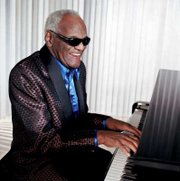Sunglasses

Sunglasses (also called sun spectacles – see usage of words for eyepieces) are a kind of visual correction aid, variously termed spectacles or glasses, which feature lenses that are coloured or darkened to screen out strong light from the eyes.
Many people find direct sunlight too bright to be comfortable, especially when reading from paper on which the sun directly shines. In outdoor activities like skiing and flying, the eye can receive more light than usual. It has been recommended to wear these kind of glasses on sunny days to protect the eyes from ultraviolet radiation, which can lead to the development of a cataract. Sunglasses have also been associated with celebrities and film actors primarily due to the desire to mask identity, but in part due to the lighting involved in production being typically stronger than natural light and uncomfortable to the naked eye.
 | Augusto Pinochet sits with sunglasses in the front of the Chilean Junta | |
Uses
Hiding one's eyes has implications in face-to-face communication: It can hide weeping, being one of the signs of mourning, makes eye contact impossible which can be intimidating, as in the stereotype of the guardian of a chain gang, or can show detachedness, which is considered cool in some circles. However, most cultures don't take them kindly, and this is supported by the fact USA and British armed forces don't wear sun glasses in Iraq. Darkened sunglasses of particular shapes may be in vogue as a fashion accessory. Note that normal glasses are very rarely worn without a practical purpose. Curiously, they can project an image of uncool nerdiness that sunglasses don't have. The impact on nonverbal communication and the cool image can be the reasons for wearing sunglasses by night or indoors.
Health use
It is important that the makers of one's sunglasses ensure that the glasses protect against UV (ultraviolet) rays. Lenses that are simply dark but do not provide UV protection may actually make things worse, as the dimmer light causes the pupils to dilate, admitting more UV rays. In the European Union, a CE mark identifies glasses fulfilling quality regulations. In the preparation for solar eclipses, health authorities often warn against looking at the sun through only sunglasses.
Fashion
The color of the lens can vary with fashion, but for general use, green, grey, or brown is recommended to avoid or minimize color distortion, that could be dangerous when, for instance, driving a car. Grey lenses are considered neutral because they do not enhance contrast or distort colors. Brown and green lenses cause some minimal color distortion, but have contrast-enhancing properties. Red lenses are good for medium and lower light conditions because they are good at enhancing contrast. Orange and yellow lenses have the best contrast enhancement and depth perception. That is why yellow lenses are commonly used by golfers and shooters. Blue and purple lenses offer no real benefits. Clear lenses are used mainly to protect the eyes from impact, debris, or chemicals.
Aside from the lens color, some sunglasses have a mirrored coating on the outer surface. This mirrored coating reflects some of the light when it hits the lens before it is transmitted through the lens making it useful in bright conditions. These mirrored coatings can be made any color by the manufacturer for styling and fashion purposes. The color of the mirrored surface is irrelevant to the color of the lens. For example, a gray lens can have a blue mirror coating, and a brown lens can have a silver coating. These type of sunglasses are sometimes called mirrorshades.
Other models have polarized lenses to reduce glare caused by light reflected from polarizing surfaces such as water as well as by polarized diffuse sky radiation (skylight).
Some models use a degradation where the top of the glass (through which the sky is looked at) is darker and the bottom is transparent.
Depending on the manufacturer, any of the above features can be combined into a set of lenses for a pair of sunglasses.
With the introduction of office computing, ergonomists can recommend mildly tinted glasses for display operators to increase contrast.
Corrective lenses can be darkened to serve the same purpose, or secondary clip-on dark lenses can be placed in front of the regular lenses. Some lenses gradually darken with bright light and lighten in darkness. These are known as photochromic lenses. People with severe visual impairment, such as the blind, often wear sunglasses so they do not make others uncomfortable with the fact that they cannot make eye contact with them (not seeing eyes may be better than seeing eyes which seem to look in the wrong direction), or to hide the eyes if their appearance is abnormal, for example due to cataracts. Before the introduction of sunglasses, one-eyed people could wear an eyepatch to not disturb other people. Some people who are severely visually impaired but still sighted wear sunglasses in order to protect their vision against glare.
Lenses are typically made from one of three materials. They include glass, plastic (usually acrylic), and polycarbonate. Glass lenses have the best optical clarity and scratch resistance, but are heavier than plastic or polycarbonate lenses. They can also shatter or break on impact. Plastic lenses are lighter than glass lenses, but are more prone to scratching. They do however, offer more resistance to shattering than glass. Polycarbonate lenses are even lighter than plastic lenses. They are shatter-resistant (but not unbreakable) making them good for impact protection.
Frames are generally made from plastic, nylon, a metal or metal alloy. Nylon frames are usually used in sports because they are light weight and flexible. They are able to bend slightly instead of breaking when pressure is applied to them. This flex can also help the glasses grip better on the wearer's face. Metal frames are usually more rigid than nylon frames thus they can be more easily damaged when participating in sporty activities, but this is not to say that they cannot be used for such activities. Because metal frames are more rigid, some models have spring loaded hinges to help them grip the wearer's face better. The end of the ear pieces and the bridge over the nose can be textured or have a rubber or plastic material to hold better. The end of the ear pieces are usually curved so that they wrap around the ear; however, some models have straight ear pieces. Oakley, for example, has straight ear pieces on all their glasses.
Onassis glasses
Onassis glasses are very large sunglasses worn by women. This style of sunglasses is said to mimic the kind most famously worn by Jacqueline Kennedy Onassis. While originally worn by Onassis in the 1960's, the glasses eventually became popular with younger American girls around the year 2000.
History
It is said that the Roman emperor Nero liked to watch gladiator fights through polished gems. Sunglasses were first used in China in the 12th century or possibly earlier. The "lenses" of these glasses were flat panes of smoky quartz, which offered no corrective powers but did protect the eyes from glare, and, according to some sources, evil spirits. Contemporary documents describe the use of such glasses by judges in Chinese courts to conceal their facial expressions while questioning witnesses. Compare the representation of "blind Justice" in Western art.
James Ayscough began experimenting with tinted lenses in spectacles in the mid-18th century. These were not "sunglasses" as such; Ayscough believed blue- or green-tinted glass could correct for specific vision impairments. Protection from the sun's rays was not a concern of his.
Sunglasses as such were introduced by Sam Foster in 1929. Foster found a ready market on the beaches of Atlantic City, New Jersey, where he began selling Foster Grants from a Woolworth on the Boardwalk.
Sunglasses would not become polarized, however, until 1936, when Edwin H. Land began experimenting with making lenses with his patented Polaroid filter.
In 2004, Oakley developed Thump, sunglasses with built-in digital audio player.
Some celebrities predominantly seen wearing sunglasses
Some celebrities are predominantly seen in public wearing sunglasses. These people include:
- Pedro Abrunhosa, Portuguese singer
- Richard Belzer comedian and actor
- Bono, singer of U2
- Ray Charles, blind musician, now deceased.
- Jose Feliciano, blind musician
- Heino German singer
- Wojciech Jaruzelski, Polish chief of state
- Elton John, in unusual tints
- Angelina Jolie, actress
- Umm Kalthum, Egyptian singer, now deceased
- Karl Lagerfeld, German fashion designer
- Jacqueline Kennedy Onassis, widow of John F. Kennedy
- Yoko Ono, Japanese artist and Lennon's wife
- Roy Orbison, singer
- Howard Stern radio host
- Masayuki Suzuki, Japanese singer
- Andy Warhol, artist
- Stevie Wonder, blind musician
- Richard Petty, NASCAR legend
- Hunter S. Thompson, journalist, deceased
Some fictional characters predominantly seen wearing sunglasses

Some fictional characters are predominantly depicted as wearing sunglasses. These include:
- John Munch, Detective in Homicide: Life on the Street,Law & Order: Special Victims Unit (played by Richard Belzer, see above)
- The Blues Brothers, musicians
- The reporter crew of the Argentinian and Spanish shows Caiga Quien Caiga
- Cyclops, from the X-Men - wears sunglasses when he is not in costume with his visor
- Matt Murdock, blind lawyer from "Daredevil"
- The Men in Black and the Men in Black of urban legend.
- Most characters from The Matrix movie. Interestingly, all of the protagonists wear rounded lenses, while the antagonists wear rectangular lenses.
- The crew from Reservoir Dogs.
- Most of the mafia members from the anime Gungrave
- Albert Wesker from the video game Resident Evil.
- Clifford, a Muppet character

